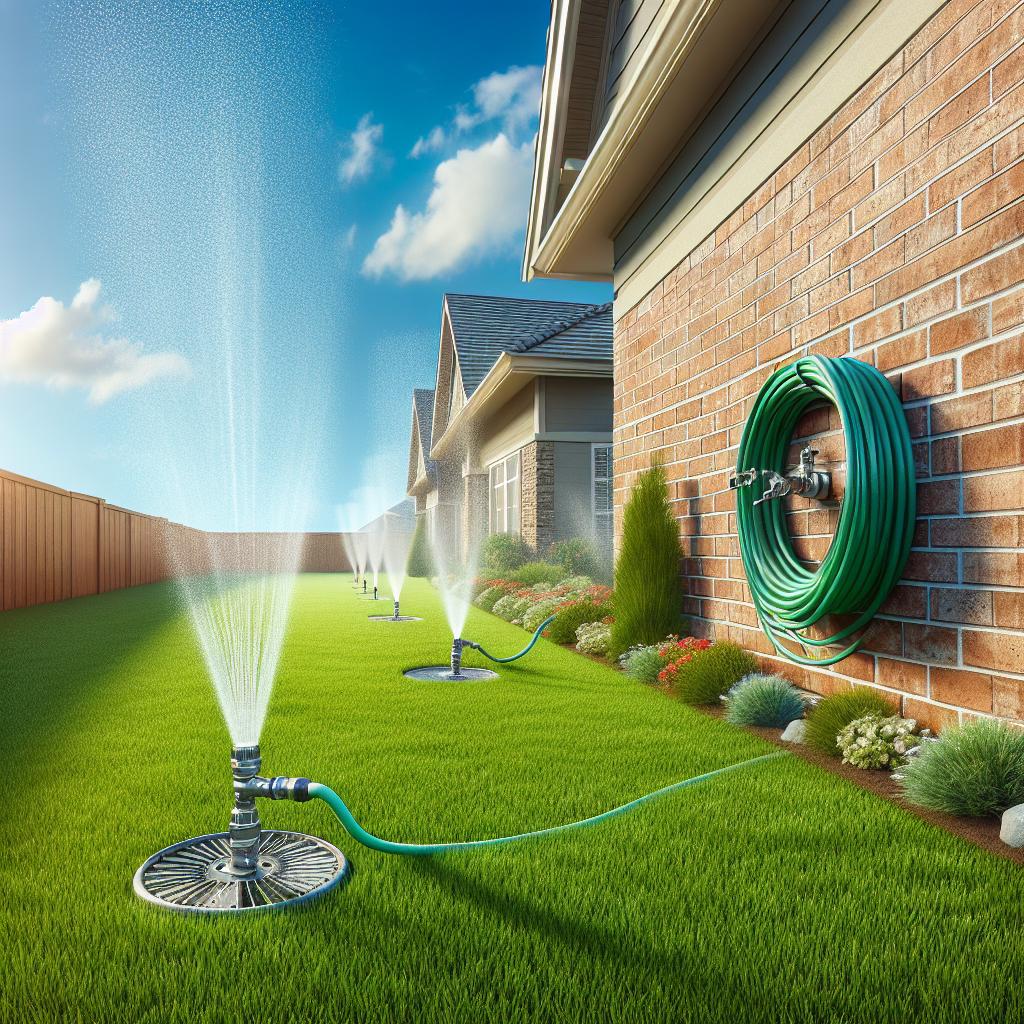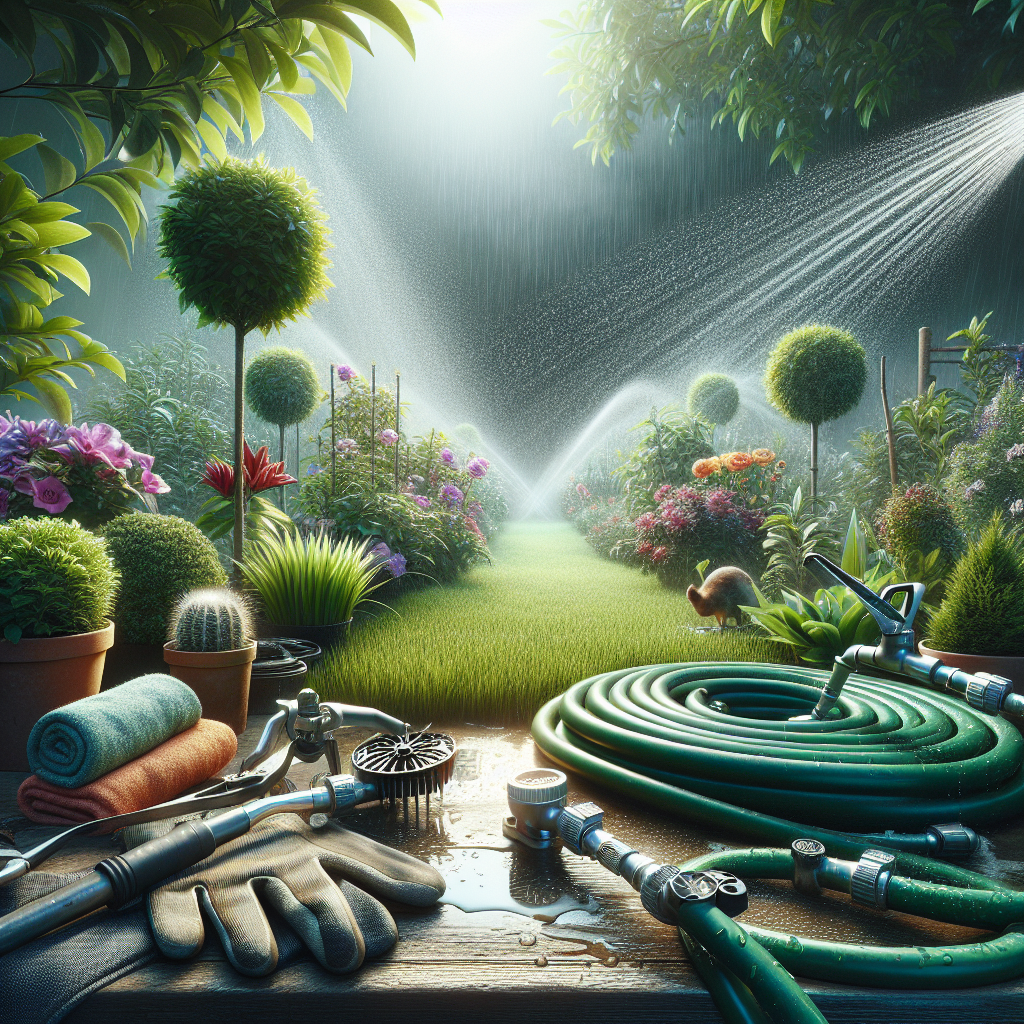Introduction to Lawn Irrigation Systems: Benefits and Essential Components
Imagine stepping outside to a lush, green lawn that thrives all season long, without the constant hassle of manual watering. This dream can become a reality with a well-designed lawn irrigation system. Not only does an effective irrigation system save you time and effort, but it also promotes water conservation and enhances the health and appearance of your lawn. In this guide, we’ll explore the benefits and essential components of lawn irrigation systems, ensuring you’re well-equipped to make an informed decision.
At its core, a lawn irrigation system is a simple and efficient method for ensuring your lawn receives the optimal amount of water it needs to flourish. The benefits of installing such a system extend beyond mere convenience; they include reduced water waste, improved plant growth, and increased property value. Before diving into installation, it’s crucial to understand the key components that make up these systems, including controllers, valves, pipes, and sprinkler heads, each playing a pivotal role in the system’s functionality.
Step-by-Step Guide to Installing a Lawn Irrigation System
Whether you’re a DIY enthusiast or planning to hire a professional, installing a lawn irrigation system involves careful planning and execution. This step-by-step guide will walk you through everything from design considerations and system layout to the physical installation of your irrigation system.
Best Practices for Maintaining Your Lawn Irrigation System for Optimal Performance
Like any other significant investment in your home, a lawn irrigation system requires ongoing maintenance to keep it functioning at its best. We’ll provide you with expert tips and techniques to maintain your system efficiently, including regular checks and adjustments that ensure effective and economical operation throughout the year.
Whether you’re in New York, California, or anywhere in between, understanding the specifics of your local climate and soil type can greatly influence the effectiveness of your irrigation system. By following this guide, you’ll not only enjoy the practical benefits but also contribute to a more sustainable and eco-friendly gardening practice. Let’s dive in and turn your lawn into a vibrant, inviting space!

If you’re ready to take your home improvement or construction project to the next level, we can help! Find trusted contractors on BuildNet, whether you’re looking for renovations, new builds, electrical work, plumbing, or anything in between. Our directory connects you with qualified professionals who can make your vision a reality.
Introduction to Lawn Irrigation Systems: Benefits and Essential Components
Imagine stepping outside to a lush, green lawn that almost smiles back at you under the sun’s warm rays. This picturesque scenario isn’t just a dream—it’s easily achievable with the right lawn irrigation system. Whether you’re a seasoned gardener or a proud homeowner looking to enhance your property’s curb appeal, understanding the ins and outs of lawn irrigation systems can significantly uplift your outdoor space. Let’s dive into the benefits these systems offer and the critical components that make them work efficiently.
Why Consider a Lawn Irrigation System?
First off, why should you even consider installing a lawn irrigation system? The reasons are plentiful:
- Water Efficiency: With environmental concerns on the rise, an irrigation system helps minimize water waste by delivering the right amount of water exactly where and when your lawn needs it.
- Time-Saving: Forget about standing with a hose or moving a sprinkler around. An automated system takes the guesswork and legwork out of watering.
- Boost in Property Value: A well-maintained lawn can significantly increase your home’s market value—a boon if you’re considering selling your house in the future.
- Uniform Coverage: Ever noticed dry patches beside overwatered areas in your yard? Irrigation systems ensure that every corner of your lawn receives an even amount of water.
- Healthier Lawn: Over or under-watering can stress your grass and plants. Proper irrigation promotes stronger root systems and healthier growth overall.
Essential Components of a Lawn Irrigation System
Now that we’ve covered the ‘why,’ let’s look at the ‘what.’ A lawn irrigation system comprises several key components, each playing a vital role in its operation:
1. Controller
The brain of the operation, the controller (or timer), allows you to set watering times and durations. Opt for a model that offers flexible scheduling and, ideally, smart features like weather sensors. These intelligent systems adjust watering based on rainfall and soil moisture levels, ensuring optimal watering without waste.
2. Valves
Valves control the water flow to different zones of your lawn. Each zone can be customized based on its specific water needs, which is ideal for maintaining varied landscape elements. Reliable valves ensure that these zones operate independently and efficiently.
3. Sprinkler Heads
The visible part of the system, sprinkler heads, can be of various types depending on your lawn’s needs:
- Rotary Sprinklers: Great for large, open areas as they can cover a lot of ground with their rotating stream of water.
- Spray Sprinklers: Best for smaller, more defined areas as they spray a continuous mist.
- Drip Irrigation: Perfect for garden beds, hedges, or any planted areas, as it delivers water directly to the roots with minimal evaporation.
Choosing the right type of sprinkler heads can help ensure that the water is used efficiently, reducing waste and promoting healthier plant life.
4. Pipes and Tubing
The unsung heroes, pipes and tubing transport water from your main supply to the sprinkler heads. They need to be durable to withstand environmental factors and the constant pressure of water flow. Materials commonly used include PVC, which offers both durability and affordability.
5. Sensors
Adding sensors to your system can significantly enhance its efficiency. Rain sensors automatically pause the watering schedule during rainfall, ensuring that you’re not over-watering and wasting precious resources. Soil moisture sensors provide real-time data on the ground’s moisture levels, allowing for adjustments in watering schedules to prevent water logging or dehydration.
6. Backflow Preventer
This safety component prevents contaminated water from flowing back into your clean water supply. It’s not only crucial for protecting your household’s water but often a legal requirement in many areas.
The Bottom Line
Installing a lawn irrigation system might seem like a significant upfront investment, but the long-term benefits—saving time, conserving water, maintaining a gorgeous lawn, and increasing property value—are undeniable. By understanding the essential components and their functions, you’re better equipped to make informed decisions that align with your landscaping needs and environmental values. Whether you’re doing a DIY install or hiring a professional from a trusted local service like BuildNet, knowing these basics will help ensure that your lawn remains a vibrant oasis.

Step-by-Step Guide to Installing a Lawn Irrigation System
Hey there, green thumbs and lawn lovers! Are you ready to take your lawn care game to the next level with an irrigation system that keeps your grass greener than a leprechaun’s wardrobe? Well, you’re in luck! Today, I’m going to walk you through the nuts and bolts of installing your very own lawn irrigation system. Whether you’re in sunny California or the rainy Northwest, a properly installed irrigation system can save you time, conserve water, and give your lawn that lush, healthy look. Let’s dig in!
Step 1: Plan Your System Layout
First off, let’s talk planning. Mapping out your irrigation system is crucial and can be kind of fun – it’s like drawing your very own garden treasure map! Start by sketching your property and marking areas like flower beds, shrubberies, and of course, your lawn. This helps you understand where you need the most water and where you can save a bit.
- Consider the water pressure: This can affect how well your sprinklers will work. You might need a pressure gauge to measure your water pressure.
- Divide your lawn into zones: Each zone will have its own watering needs based on sun exposure, type of plants, and soil condition.
Step 2: Gather Your Tools and Materials
Got your plan? Great! Now it’s time to gather your gear. Here’s what you’ll generally need:
- PVC or polyethylene piping
- Sprinkler heads and valves
- Timer or controller (if you want to automate things)
- Trenching shovel or a power trencher
- Pipe cutter
- Glue and primer for PVC, or clamps for poly pipes
Local hardware stores or landscaping suppliers should have everything you need. Don’t forget to check for any permits required by your city or homeowners association before you start digging!
Step 3: Digging the Trenches
It’s time to get a little dirty! Digging trenches might sound tough, but it’s easier if you plan properly. Trenches should be about 6 to 12 inches deep, depending on your area’s frost line and the type of soil.
- Keep it tidy: Try to keep the soil you dig up close to the trench and in a neat pile. You’ll need it again to fill the trenches after laying the pipes.
Step 4: Install Pipes and Sprinkler Heads
Now that you have your trenches, it’s time to lay down the pipes. Whether you chose PVC or polyethylene, make sure the connections between pipes are secure to avoid leaks.
- For PVC pipes: Use primer and glue on the joints.
- For poly pipes: Use clamps to secure the fittings.
Once your pipes are laid out, attach the sprinkler heads at designated points within your layout. Make sure they’re snug and well-aligned to ensure even water distribution.
Step 5: Connect the Water Source and Install the Controller
Almost there! Connect your main water line to the irrigation pipes. This might require some plumbing skills, so if you’re not confident, it might be a good time to call in a professional from a local home service directory like BuildNet. Once connected, install a controller to automate your sprinklers. Most controllers are quite user-friendly and come with a manual.
Step 6: Test and Fine-Tune
Give your new system a test run. Check for any leaks or misaligned sprinkler heads. Adjust the timers and settings on your controller based on the specific needs of your zones.
Testing and adjusting might take a few cycles to get right, but once you do, you’ll be saving time and water, and your lawn will be the envy of the neighborhood!
Step 7: Fill in the Trenches
Last step, I promise! Once everything is tested and running smoothly, fill in the trenches with the soil you dug up. Give the area a good water to help settle the soil back into place and help with recovery.
And there you have it! You’re now the proud owner of a brand-new, fully functioning lawn irrigation system. Remember, installation is just the beginning. Regular maintenance is key to keeping your system efficient and your lawn gorgeous.
Best Practices for Maintaining Your Lawn Irrigation System for Optimal Performance
Hey there, green thumbs and lawn lovers! Are you looking to keep your lawn irrigation system running like a well-oiled machine? Well, you’re in the right place. Proper maintenance is key to ensuring your system performs efficiently, conserves water, and keeps your lawn looking lush and healthy. Let’s dive into some best practices that will help you achieve just that, and ensure your system is the envy of the neighborhood!
Regularly Check and Clean the Sprinkler Heads
Just like any other part of your home, your lawn’s sprinkler heads need some TLC to keep them free of dirt, grass, and debris. It’s wise to:
- Inspect sprinkler heads monthly: Look for clogs, damage, or wear and tear. A clogged sprinkler can affect the water distribution, impacting your lawn’s health and water usage.
- Clean them gently: Use a small brush and water to carefully clean the heads. Avoid using harsh chemicals or sharp objects that could damage them.
- Adjust for coverage: Make sure each sprinkler head is correctly aligned and covering its intended area. Misaligned heads waste water and can lead to dry spots or water logging.
Monitor System Pressure
Inconsistent water pressure can wreak havoc on your irrigation system. Too high, and your pipes might burst; too low, and your grass won’t get enough water. Keep these tips in mind:
- Use a pressure gauge: Attach it to a hose bib near your sprinkler system to check the pressure. Ideal operation pressure varies, but it’s usually around 30-50 psi.
- Install a pressure regulator: If you consistently notice high pressure, a regulator can help maintain the pressure at a safe level.
- Consult a professional: If you’re unsure about the readings or adjustments, calling in a professional can save a lot of guesswork and potential damage.
Seasonal Adjustments and Checks
As the seasons change, so do the needs of your lawn and the setup of your irrigation system:
- Spring setup: Start the season by slowly opening the main water valve to avoid a surge of pressure. Check for any leaks or damage that could have occurred during the winter.
- Summer scrutiny: Your lawn will likely need more water. Adjust the timer on your system to increase watering frequency, especially during heat waves.
- Fall maintenance: Begin to reduce watering frequency as the weather cools. Preparing your system for winter by draining all the water out can prevent freezing damage.
- Winterization: This is crucial if you live in a freeze-prone area. Fully drain your system and, if possible, blow out residual water with compressed air. Insulate above-ground pipes and shut down the system to prevent damage.
Update and Upgrade System Components
Technology advances and so should your irrigation system. Upgrading to a smart irrigation controller, which adjusts watering based on weather conditions, or installing moisture sensors can greatly increase efficiency and reduce waste. Consider:
- Smart controllers: These devices can adjust watering based on rainfall, soil moisture, and even weather forecasts, ensuring your lawn gets exactly what it needs.
- Efficient sprinkler heads: Upgrading to high-efficiency nozzles can reduce water usage and improve water distribution.
- Leak detection: Newer systems often include leak detection technology, alerting you to issues before they become serious problems.
Keep an Eye on Your Water Bill
Unexpected increases in your water bill can often indicate a leak or inefficiency in your system. It’s a good idea to:
- Compare monthly bills: Look for seasonal trends and any unusual spikes that could indicate leaks.
- Conduct regular audits: Have a professional perform a detailed audit of your system every few years to ensure everything is in top working order.
Engage with Professionals
While many aspects of irrigation system maintenance can be DIY, don’t underestimate the value of professional help:
- Professional servicing: Having your system checked by a professional at least once a year can help catch issues you might have missed.
- Stay informed: Regulations regarding water usage and irrigation systems can change. Professionals can ensure you’re always in compliance and using the best practices.
Maintaining your lawn irrigation system may seem like a chore, but with these practices, it can be a straightforward part of your home care routine. Not only will this keep your lawn looking great, but it will also help conserve water and save money in the long run. So, grab your garden gloves, and let’s make your lawn the pride of the neighborhood!

Frequently Asked Questions About Lawn Irrigation Systems
What are the benefits of installing a lawn irrigation system?
Installing a lawn irrigation system provides numerous advantages, including water conservation through targeted watering schedules, enhanced lawn health by distributing water evenly across your lawn, and increased property value. Moreover, it saves you time and effort compared to manual watering.
What are the key components of a lawn irrigation system?
A typical system includes a controller (timer), valves, sprinklers, and piping. The controller sets the watering schedule, valves control the water flow, sprinklers distribute the water, and pipes transport the water to various parts of the lawn.
How do I choose the right type of sprinkler heads for my lawn?
Selection depends on the size and shape of your lawn. Rotating sprinklers are ideal for large, open areas, while fixed or misting sprinklers are better for smaller, more intricate garden spaces. Consulting with a professional can ensure you choose the best type for your needs.
What should I consider before installing a lawn irrigation system?
Consider the size and type of your lawn, local climate, and soil type. Also, think about water conservation regulations in your area. Planning with these factors in mind helps achieve an efficient and sustainable irrigation system.
Can I install a lawn irrigation system myself?
While it’s possible to DIY, professional installation ensures that the system functions efficiently and complies with local building codes. Contractors can also provide valuable insights into the best system for your landscape.
How often should I maintain my irrigation system?
Maintenance should be performed at least twice a year, during spring and fall. This includes checking for leaks, cleaning filters, and adjusting sprinkler heads. Regular maintenance ensures your system operates at peak efficiency.
What is the cost of installing a lawn irrigation system?
The cost can vary widely depending on the size of your lawn and the complexity of the system. On average, homeowners might spend between $2,000 and $5,000. Getting quotes from several contractors can help you find the best price and service.
How can an irrigation system save me money on my water bill?
Properly installed and maintained irrigation systems use water more efficiently than manual watering, reducing wastage and ultimately lowering your water bills. Advanced systems can adjust schedules based on weather conditions, preventing overwatering.
Are there environmentally friendly irrigation options?
Yes! Drip irrigation systems target specific areas directly at the root zone, minimizing evaporation and runoff. Smart controllers adjust watering based on real-time weather updates, enhancing water conservation efforts.
How do I troubleshoot common problems in my irrigation system?
Common issues include clogged sprinkler heads, leaks in the pipes, and faulty valves. Regular inspections can help you spot and address these problems early. If troubleshooting seems complex, consider calling a professional.
Conclusion
In conclusion, a well-designed and properly maintained lawn irrigation system can not only transform your garden into a lush, green haven but also provide significant water savings and increase the overall value of your property. Whether you’re considering the installation of a new system or looking to upgrade your existing setup, the benefits are clear.
Remember, while DIY projects can be tempting, professional installation by a licensed contractor ensures your system is set up efficiently and compliantly. If you’re ready to take the next step, why not reach out for a free quote from a trusted contractor through the BuildNet website? With expert advice and competitive pricing, you’re sure to find the perfect solution tailored to your lawn’s needs. Let’s make your dream lawn a reality!







